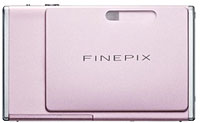 Thinner than a whippet with Montezuma’s Revenge, Fujifilm’s new FinePix Z3 sports a 5.1 million pixel sensor, ISO reaching down to the dim lights of 1600 and a 36-108mm (3x), F3.5 – 4.2 lens.
Thinner than a whippet with Montezuma’s Revenge, Fujifilm’s new FinePix Z3 sports a 5.1 million pixel sensor, ISO reaching down to the dim lights of 1600 and a 36-108mm (3x), F3.5 – 4.2 lens.
Apparently created with the laydees in mind, this minor update to the Z2 camera comes with improved resolution, an Intelligent-Flash mode and an improved 2.5-inch screen, with the camera available in silver, metallic blue and girly-girly light pink.
Fluffing up their announcement with a bit of cod-science, Fujifilm reckon that their research has revealed that most photos taken by women are ‘people pictures’* snapped in low light situations and in close proximity to the subject – the kind of photos that are notoriously hard to grab without camera shake or bleaching out faces..
 (*A quick straw poll around the office found this claim to be total bollocks, by the way).
(*A quick straw poll around the office found this claim to be total bollocks, by the way).
We’re sure that the ladies of the world will be lining up to thank Fujifilm for the Super CCD and Real Photo Processor II in the Z3 which combines with the camera’s high sensitivity (up to ISO1600) and Intelligent-Flash system to help banish those low-light photo blues.
Fujifilm’s Intelligent-Flash system claims to work by combining a well-exposed background and ‘natural skin tones’ on subjects in the foreground, with a ‘Dual-Shooting Mode’ blasting off two consecutive shots (one with flash and one without flash) to see which comes out best.
Rounding off the feature set is 14 pre-programmed scene positions, high resolution (230K Pixels) 2.5 inch LCD screen, 10 MB internal memory and ‘TV-quality’ VGA movie recording of 30 fps with sound
Availability and pricing to be announced.
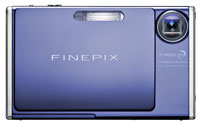 Specifications:
Specifications:
Sensor – 5.1 million effective pixels
Image sizes – 2592 x 1944, 2736 x 1824 (3:2), 2048 x 1536, 1600 x 1200, 640 x 480
Movie clips – 640 x 480 @ 30fps, 320 x 240 @ 30fps, Mono sound
File formats – JPEG Exif v2.2, DPOF, AVI Motion JPEG
Lens – 36 – 108mm equiv, F3.5 – 4.2
Image stabilization – No
Conversion lenses – No
Digital zoom – up to 5.7x
Focus – Auto focus, Normal: approx 60cm – infinity, Macro: approx 8cm (wide)
Metering – TTL 256 zone
ISO sensitivity – Auto, ISO 64 – ISO 1600
Shuttter speed – 4 – 1/1000 sec
Aperture – F3.5 / F5.0 / F8 3 steps
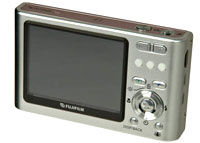 Modes – Auto, Anti-Blur, Scene Position, Macro, Movie, Burst / Continuous
Modes – Auto, Anti-Blur, Scene Position, Macro, Movie, Burst / Continuous
Scene modes – Natural Light, Natural Light with Flash, Portrait, Landscape, Sport, Night, Fireworks, Sunset, Snow, Beach, Museum, Party, Flower, Close-up, Text
White balance – Auto, Manual (Fine, Shade, Fluorescent Light (Daylight, Warm White & Cool White), Incandescent Light
Self timer – 2 or 10 sec
Continuous shooting – Top-3 (max 2.2 fps up to 3 frames), Final-3 (max 2.2 fps up to 3 frames), Long-period (max 0.7 fps up to memory card size)
Flash – Auto, Red-eye reduction, On / Off, Slow sync, Red-eye reduction + slow sync
Range – Wide approx 0.3 – 3.0m, Tele approx 0.6 – 2.3m
Viewfinder – No
LCD monitor – 2.5-inch, 230,000 pixels
Connectivity – NTSC / PAL, USB 2.0 High speed
Storage – xD-Picture Card, 10MB internal memory
Weight (no batt) 130 g (4.6 oz)
Dimensions 92.7 x 56.7 x 27.8 mm (3.6 x 2.2 x 1.1 in)
 LG has unveiled the KG810 clamshell phone; a super slim, quad band GSM handset which will be sold in Asia, China, Europe and CIS markets.
LG has unveiled the KG810 clamshell phone; a super slim, quad band GSM handset which will be sold in Asia, China, Europe and CIS markets.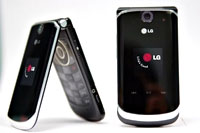 Under the screen there’s a touch-sensitive keypad and a fairly healthy 128 MB of internal memory.
Under the screen there’s a touch-sensitive keypad and a fairly healthy 128 MB of internal memory.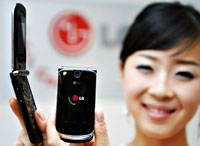 Although these stars were clearly happy to scoop up any expensive freebies coming their way, when it came to electing the UK’s “primary Chocolate phone ambassador,” LG found the celebrity cupboard somewhat bare.
Although these stars were clearly happy to scoop up any expensive freebies coming their way, when it came to electing the UK’s “primary Chocolate phone ambassador,” LG found the celebrity cupboard somewhat bare.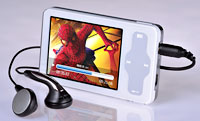 After consulting the well thumbed iPod design book, Chinese electronics manufacturers Meizu have rolled out their new Meizu Mini, a truly Lilliputian Personal Media Player.
After consulting the well thumbed iPod design book, Chinese electronics manufacturers Meizu have rolled out their new Meizu Mini, a truly Lilliputian Personal Media Player.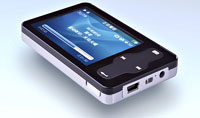 Other onboard gizmos include Synchronized Lyric Display, E-book, alarm clock, calculator, calendar and some (unspecified) games.
Other onboard gizmos include Synchronized Lyric Display, E-book, alarm clock, calculator, calendar and some (unspecified) games.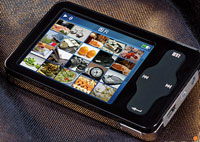 So far we’ve only seen Chinese language screen shots but the interface seems crisp and slick enough to us.
So far we’ve only seen Chinese language screen shots but the interface seems crisp and slick enough to us.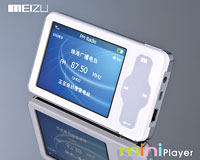 The player comes with a white or black finish and a metal back just like the – yep, you’ve guessed it – iPod.
The player comes with a white or black finish and a metal back just like the – yep, you’ve guessed it – iPod.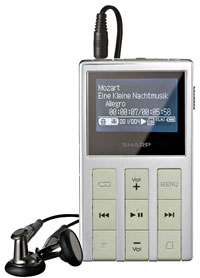 Details are still a bit sketchy on these shiny new fellas, but Sharp’s new range of flash based MP3 players sure look mighty purdy to our jaded eyes.
Details are still a bit sketchy on these shiny new fellas, but Sharp’s new range of flash based MP3 players sure look mighty purdy to our jaded eyes.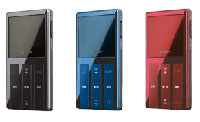 As is de rigueur these days with (non Apple) MP3 players, there’s an FM tuner onboard with direct audio encoding – great for recording radio shows or capturing your mobile mumblings via the built in microphone
As is de rigueur these days with (non Apple) MP3 players, there’s an FM tuner onboard with direct audio encoding – great for recording radio shows or capturing your mobile mumblings via the built in microphone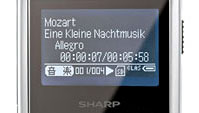 The measurements of the MP-B200 and MP-B300 are 49 x 87.6 x 8.9mm – pretty damn small, but positively bun-scoffing compared to 6.8mm thickness of the Apple iPod.
The measurements of the MP-B200 and MP-B300 are 49 x 87.6 x 8.9mm – pretty damn small, but positively bun-scoffing compared to 6.8mm thickness of the Apple iPod.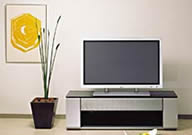 The geek bit
The geek bit 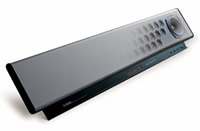 Tech specs
Tech specs 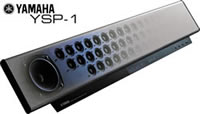 Yamaha’s YSP-1 is a marvel of technology, it’s about 42 inches long by 4 inches high and about 4 inches deep but can produce 5.1 audio that really does sounds like a conventional set-up with speakers in-front and behind you.
Yamaha’s YSP-1 is a marvel of technology, it’s about 42 inches long by 4 inches high and about 4 inches deep but can produce 5.1 audio that really does sounds like a conventional set-up with speakers in-front and behind you.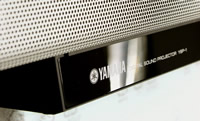 A box is a box without careful set-up
A box is a box without careful set-up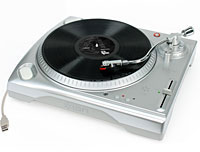 If you’ve got a big stack of top notch vinyl gathering dust at home, you may want to consider using this natty USB Turntable to record the platters that matter straight on to your desktop or laptop PC.
If you’ve got a big stack of top notch vinyl gathering dust at home, you may want to consider using this natty USB Turntable to record the platters that matter straight on to your desktop or laptop PC.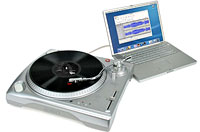 The turntable can also be hooked up to any home stereo with CD or auxiliary inputs so you can rock out to your old punk rock 45s after a night in the pub.
The turntable can also be hooked up to any home stereo with CD or auxiliary inputs so you can rock out to your old punk rock 45s after a night in the pub.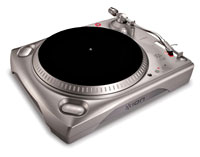 Using your existing turntable
Using your existing turntable Samsung has announced the imminent release of the world’s first solid state laptops, in the shape of the Q1,an Ultra Mobile PC and the Q30-SSD, a 12.1-inch screen notebook PC
Samsung has announced the imminent release of the world’s first solid state laptops, in the shape of the Q1,an Ultra Mobile PC and the Q30-SSD, a 12.1-inch screen notebook PC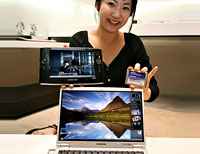 The company also said that it was only selling the SSD laptops in South Korea to reduce the risks from teething problems.
The company also said that it was only selling the SSD laptops in South Korea to reduce the risks from teething problems.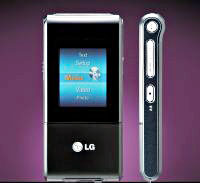 It may not have the swish designer lines of the iPod and the name may roll off the tongue as smoothly as a mouth full of dry nuts, but LG Electronics new MFJM53 MP3 player looks more than a bit useful.
It may not have the swish designer lines of the iPod and the name may roll off the tongue as smoothly as a mouth full of dry nuts, but LG Electronics new MFJM53 MP3 player looks more than a bit useful.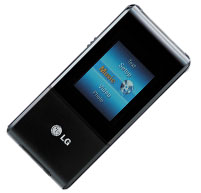 Although we like the look of this fella – the feature set particularly impresses – the lack of a scroll/clickwheel is going to seriously hamper its ability to challenge the dominance of the uber-iPod.
Although we like the look of this fella – the feature set particularly impresses – the lack of a scroll/clickwheel is going to seriously hamper its ability to challenge the dominance of the uber-iPod.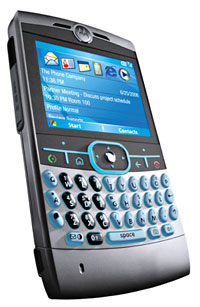 Months later than expected, Motorola’s new ‘Blackberry-killer’ smartphone, the Moto Q has finally been launched on the Verizon network in the US.
Months later than expected, Motorola’s new ‘Blackberry-killer’ smartphone, the Moto Q has finally been launched on the Verizon network in the US.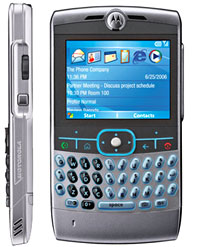 Shockley insisted that the Q is for people with a “life balance” (a what?) who want to use their phones to listen to music, take photos, record short videos and play games.
Shockley insisted that the Q is for people with a “life balance” (a what?) who want to use their phones to listen to music, take photos, record short videos and play games.